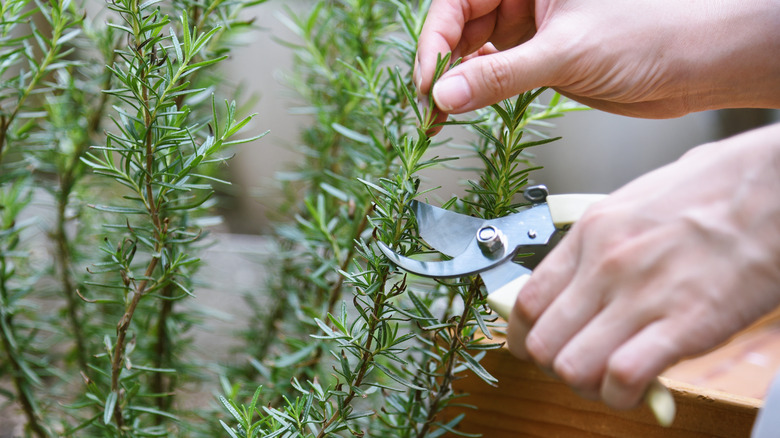How And When To Harvest Rosemary For The Best Flavor
The piney aroma and earthy bite of Salvia rosmarinus, or rosemary, is perennially popular, and the reason why it has earned a permanent spot in so many kitchens and garden beds. This hardy, evergreen shrub isn't just beautiful with its pale blue and purple blooms – it's practical too. As well as fresh rosemary being a natural mosquito repellent, this is a versatile herb and one you'll reach for in your garden time and time again.
But getting the most out of your rosemary isn't just a matter of snipping when you feel like it. For peak flavor, timing and technique both matter. While the plant can be harvested year-round in milder climates thanks to its evergreen nature, the new sprigs that appear in summer are where the real magic happens. Rosemary's flavor is at its peak when the plant is actively growing and there are young new tips. The tender sprigs that have just grown are the most flavorful and aromatic – perfect for drying or using fresh in everything from roasted meats to infused oils. A little regular pruning keeps the plant healthy and productive, and you can dry this fresh summer rosemary to create a steady supply to enjoy through the winter months.
How to harvest flavorful rosemary
Morning is the best time to harvest rosemary. The sweet spot is when the dew has dried and before the midday sun gets too strong, as this is when rosemary's essential oils are most concentrated, giving you maximum flavor and fragrance in every snip.
When you're ready to harvest and store your fresh garden herb, grab a pair of sharp, clean scissors or garden shears and clip just above a leaf node. Just be sure not to trim more than a third of the shrub at once, as heavy pruning can stress the plant and slow its growth. After cutting, store the sprigs in the fridge to help preserve their potent oils as cooler temperatures can slow the loss of flavor compounds. For the most vibrant taste and aroma, try to use them as soon as possible.
Rosemary may be tough and sun-loving, but it's not completely invincible. While this resilient herb thrives on minimal fuss and full sunlight, and works well when planted together with other drought-tolerant herbs, it only stays evergreen in USDA plant hardiness zones 8 and above. If you live in zone 7 or lower, you'll want to bring your rosemary indoors once temperatures start to dip. Make sure it's planted in a well-draining pot, placed in a sunny spot with good air circulation – think a bright windowsill or sunroom — to keep it happy and thriving through the colder months.

